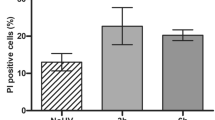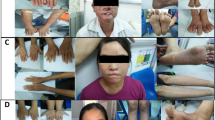Abstract
BLOOM'S syndrome (BS) is a rare, autosomal recessive condition of pre-natal and post-natal growth retardation, sun-induced telangiectatic erythema, impaired immunological function and predisposition to cancer1,2. BS cells show a high incidence of chromosome breakage and rearrangement often with abnormal nuclear morphology. Chromosome exchanges appear mainly to involve homologous chromosomes, while sister chromatid exchanges are abnormally frequent3. These features suggest a defect of DNA replication or repair. In particular, the high incidence of sister chromatid exchanges may be explained if free ends in the DNA, resulting from abnormalities of DNA synthesis and/or repair, act as initiation points for exchange4. We report here that BS fibroblasts are abnormally sensitive to ultraviolet irradiation in vitro and show a rate of DNA synthesis and DNA chain maturation lower than controls. They do not, however, have defective bypass of ultraviolet light-induced lesions during DNA replication as xeroderma pigmentosum (XP) variants5.
This is a preview of subscription content, access via your institution
Access options
Subscribe to this journal
Receive 51 print issues and online access
$199.00 per year
only $3.90 per issue
Buy this article
- Purchase on Springer Link
- Instant access to full article PDF
Prices may be subject to local taxes which are calculated during checkout
Similar content being viewed by others
References
Bloom, D., Am. J. Dis. Child., 88, 754–758 (1954).
German, J., in Chromosomes and Cancer (edit. by German, J. ), 601–617 (Wiley, New York, 1974).
Chaganti, R. S. K., Schonberg, S., and German, J., Proc. natn. Acad. Sci. U.S.A., 71, 4508–4512 (1974).
Polani, P. E., in Congenital Disorders of Erythropoiesis, Ciba Foundation Symp., 37, new series (edit. by Fitzsimons, D. W. ), 261 306 (Associated Scientific, Amsterdam, 1976).
Lehmann, A. R. et al., Proc. natn. Acad. Sci. U.S.A., 72, 219–223 (1975).
Lehmann, A. R., J. molec. Biol., 66, 319–337 (1972).
Carrier, W. L., and Setlow, R. B., Analyt. Biochem., 43, 427–432 (1971).
Hand, R., and German, J., Proc. natn. Acad. Sci. U.S.A., 72, 758–762 (1975).
Huberman, J. A., and Riggs, A. D., J. molec. Biol., 32, 327–341 (1968).
Housman, D., and Huberman, J. A., J. molec. Biol., 94, 173–181 (1975).
Callan, H. G., Cold Spring Harb. Symp. quant. Biol., 38, 195–203 (1974).
Cleaver, J. E., J. invest. Derm., 54, 181–195 (1970).
Regan, J. D., Setlow, R. B., Carrier, W. L., and Lee, W. H., in Adv. Radiat. Res. : Biol. Med. (edit. by Duplan, J. F., and Chapiro, A.), 1, 119–125 (Gordon and Breach, New York, 1973).
Author information
Authors and Affiliations
Rights and permissions
About this article
Cite this article
GIANNELLI, F., BENSON, P., PAWSEY, S. et al. Ultraviolet light sensitivity and delayed DNA-chain maturation in Bloom's syndrome fibroblasts. Nature 265, 466–469 (1977). https://doi.org/10.1038/265466a0
Received:
Accepted:
Published:
Issue Date:
DOI: https://doi.org/10.1038/265466a0
Comments
By submitting a comment you agree to abide by our Terms and Community Guidelines. If you find something abusive or that does not comply with our terms or guidelines please flag it as inappropriate.



